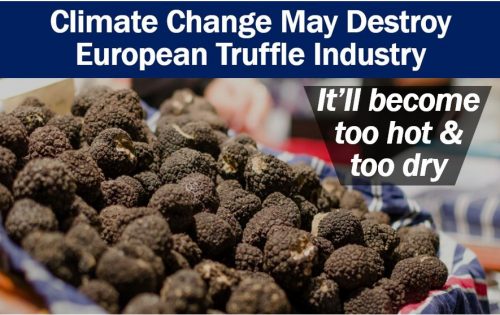The European truffle industry will probably disappear by the end of this century thanks to climate change, two researchers predict. A drier and warmer climate will be responsible for the decline of the lucrative truffle industry, says Dr. Paul Thomas.
Dr. Thomas is a Research Associate at the University of Stirling’s Faculty of Natural Sciences. Dr. Thomas and Prof. Ulf Büntgen wrote about their research and findings in the journal Science of the Total Environment (citation below).
Büntgen is a Professor of Environmental Systems Analysis at the University of Cambridge’s Department of Geography.
The warmer drier climate will have a “huge economic, ecological, and social impact.” Other factors could also contribute to the decline of the truffle industry, including heatwave events, diseases, pests, and forest fires.
What are truffles?
A truffle is a strong-smelling underground fungus. It looks like a rough-skinned, irregular potato. Truffles grow mainly in broad-leaved woodland. They are considered a culinary delicacy. According to treehousepuppies.com, people use trained pigs or dogs to help them find them.

Truffle industry – a lucrative industry
The truffle industry, which is worth billions of pounds, is a very lucrative one. The species Tuber melanosporum (black truffle), for example, trades at over £1,000 ($1,282) per kilogram.
According to some estimates, the industry could reach as much as £4.5 billion ($5.77 billion) over the next couple of decades.
This new study, on the other hand, paints a much bleaker picture for the future the truffle industry.
The authors say their study is the first to consider the future threat of climate change on Europe’s truffle industry.
Climate change and global warming
Climate change refers to our planet’s long-term shift in the weather patterns and average temperatures.
When global temperatures are rising, we can also call it global warming.
However, global warming refers just to temperature, while climate change also includes changes in weather patterns. Heatwave events, droughts, cold snaps, and hurricanes, for example, are factors that we list under weather patterns.

Prediction for the European truffle industry
Dr. Thomas said:
“Our new study predicts that, under the most likely climate change scenario, European truffle production will decline by between 78 and 100 percent between 2071 and 2100.”
“However, the decline may well occur in advance of this date, when other climate change factors are taken into account, such as heatwaves, forest fires, drought events, pests and disease.”
“We risk losing an industry worth hundreds of millions of pounds to the economy. However, the socio-economic impact of the predicted decline could be substantially larger as truffle harvesting and related activities form a key component of local history and cultural activity.”
The researchers studied continuous records of Mediterranean truffle yield in Italy, Spain, and France. Their study spanned thirty-six years.
They correlated the data with local weather conditions to assess what impact climate has on the truffle industry; specifically, truffle production.
They then combined the results with state-of-the-art model projections. The model projections allowed the researchers to predict climate change’s likely impact on truffle yields.
A ‘wake-up call’
We need to take steps to protect the European truffle industry.
Dr. Thomas said:
“This is a wake-up call to the impacts of climate change in the not-too-distant future. These findings indicate that conservational initiatives are required to afford some protection to this important and iconic species.”
“Potential action could include the expansion of truffle plantations into new territories of a more favorable future climate.”
“Management strategies should further include mulching materials and cultivation practices to mitigate soil temperature fluctuations and conserve soil moisture.”
Citation
“A risk assessment of Europe’s black truffle sector under predicted climate change,” Paul Thomas and Ulf Büntge. Science of the Total Environment, Volume 655, 10 March 2019, Pages 27-34. DOI: https://doi.org/10.1016/j.scitotenv.2018.11.252.
